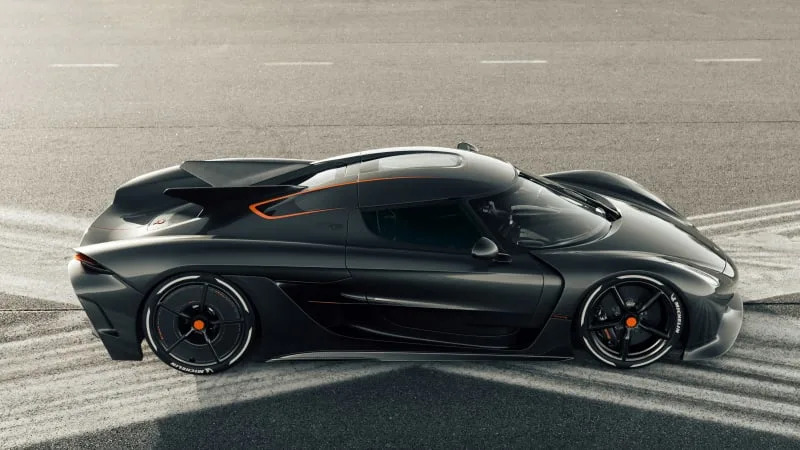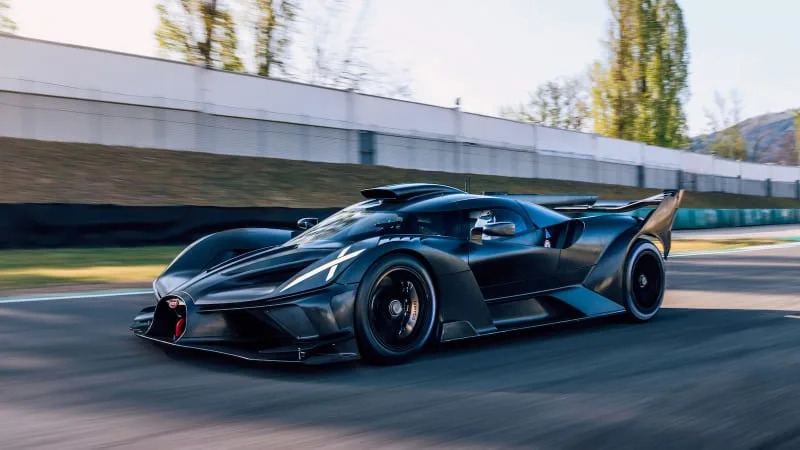It wasn’t that long ago that the idea of reaching 200 miles per hour in a car, on a road, seemed nearly impossible. As you probably know by now, those days are long gone. And once that barrier was crossed, the automotive world immediately started looking at the next triple-digit benchmark: 300 miles per hour. It may have taken a while, but the 300-mph barrier has been crossed, and some cars have gone way beyond that seemingly insane speed figure. While some of these speeds have been achieved in simulations (including the fastest car listed below), there is little doubt that a driver with nerves of steel and a heavy right foot can indeed propel several cars to speeds of 300 miles per hour and more.
Interestingly, it’s not just one car or automaker that’s in the 300 mph club, as a handful of models have secured a spot on the leaderboard (sometimes claimed, but not yet proven).
The fastest car in the world is: Koenigsegg Jesko Absolut (330 MPH)

That title goes to the Koenigsegg Jesko Absolutewhich recently broke four world records for speed and performance in a single day. The headline figure achieved by the Jesko Absolut with Racelogic timing gear was a 0-400-kmh-0 time of 27.83 seconds. For those of us who measure in miles instead of kilometers, that’s zero to 25o(ish) miles per hour and back to zero again in under 28 seconds. Get rid of the brakes performance and the Koenigsegg Jesko Absolut went from 0-250 in 19.20 seconds.
But this article is all about top speed. According to Koenigsegg, the Jesko Absolut is capable of a staggering top speed of 330 mph. The car’s twin-turbocharged 5.0-liter V8 makes 1,600 horsepower and 1,106 pound-feet of torque, which plays a major role in delivering that speed, but Koenigsegg’s engineers gave the car much more than just staggering power.
The Jesko Absolut has a super-slick drag coefficient of 0.278 and a nine-speed gearbox that shifts so quickly it’s almost imperceptible. Koenigsegg calls it a Light Speed Transmission (LST), and says the gear changes happen at “almost the speed of light.” While that may be a slight exaggeration, the gearbox is impressive, with multiple wet multi-plate clutches and a super-light construction.
As Koenigsegg says: “The Jesko Absolut is destined to reach higher, more extraordinary speeds than any Koenigsegg or any other fully homologated car.”
How much does the Koenigsegg Jesko Absolut cost?
If you’re reading that and wondering how much the fastest car in the world costs, that price tag is just a staggering number on the Jesko Absolut’s spec sheet. All 125 Absolut cars offered sold out, at a price of nearly $3 million. Of course, being able to afford the Koenigsegg is only the first step in realizing its full potential. There are few places on the map that can support a 300-plus mph speed run, and the ones that can aren’t conveniently located. That said, it’s likely that many of the people who dropped the cash on a Jesko Absolut will be happy with the bragging rights rather than the speed.
The Jesko Absolut is the fastest, and does so at a speed well over a few miles per hour above average, but the other cars in the 300 mph club are nearly as impressive.
Other cars that go faster than 300 mph

The Bugatti Bolide delivers 1,847 horsepower and 1,365 pound-feet of torque from a quad-turbo 8.0-liter W16. Top speed is 311 mph and the styling is just as wild and over-the-top.
Unlike the Koenigsegg, the Bugatti is a track-only affair. Although it shares an engine and some of the underlying structure with the road-legal Chiron, Bugatti chose to restrict the Bolide to track use only. While that’s a shame, especially considering the car’s roughly $4.4 million price tag, not having to build a car that adheres to road-legal regulations gave Bugatti the freedom to create a brutal car with a speed that defies logic. The Bolide is also far more exclusive than the Koenigsegg, as Bugatti only produced 40 of these extreme cars.
The car’s suspension is much stiffer than the Chiron’s, and the car rides on Michelin slicks. It uses a revised carbon monocoque and is built using a series of 3D-printed parts. Without the need to worry about curbs, speed bumps and pedestrians, Bugatti can go wild with aerodynamics and bodywork, resulting in a car that looks like it could cut you off.
What does it take to make a car that can go faster than 300 mph?
The Jesko Absolut and Bolide make reaching 300+ mph easy, which you’d expect for their multi-seven-figure price tags, but it takes a lot to reach their dizzying top speeds. In addition to the miles of crystal-clear asphalt, the cars have to be exceptionally aerodynamic and capable of consuming large amounts of air, and the fuel consumption at those speeds is immense. Engineers have to design a car that can easily cut through the air while also creating enormous downforce to keep it on the ground.
Adding thousands of pounds of downforce puts stress on almost every part of the car, especially the suspension and tires. The dampers have to handle the temporarily heavier car while keeping the tires in contact with the asphalt. At 300 mph, even subtle bumps in the road come faster and much harder, so the car has to be able to handle it.
Tires take a particularly hard hit during high-speed runs, as their sidewalls are compressed by all the downward force. They’re also exposed to extreme temperatures from the friction created by rubber clawing at the road surface at 300 mph. At that speed, tires are spinning thousands of times per minute, so they also need to be strong enough to hold their shape despite the intense rotational forces. Finally, high speeds do strange things to the weight of vehicle components, such as the tire pressure check sensors, which can become several times heavier than normal at a rotational speed of 480 km/h, and which can cause wheel imbalances and other problems.
What about the previously fastest cars from Ferrari and Porsche?

While we are now talking about cars that reach speeds of over 300 mphthe first car to reach 200 mph did so over 50 years ago. The 1969 Dodge Charger The Daytona reached 200 mph in March 1970 at Talladega in Alabama. That’s right, the first car to hit 200 didn’t have an Italian name on its nose, although many of the most famous cars in the 200 club do. That said, the Charger The Daytona, like today’s Bugatti Bolide, was not street legal and the first road car to achieve the standard was a Ferrari.
A few years after the Clever trick‘s record-breaking run, the Ferrari F40 (below left) reached 200 mph as the first production car to hold the record. Its twin-turbocharged 2.9-liter V8 produced 471 hp when new, giving it a 0-60 mph time of 3.8 seconds and a top speed of 201 mph. Interestingly, the most impressive Porsche The 959 (bottom right) did not quite reach the speed of the F40 at the time and “only” reached 317 km/h.


Electric energy can change everything
As the automotive world moves toward full electrification, questions arise about the top speed of electric vehicles and battery power, but there are at least five models for sale today with a top speed of over 200 mph. The smooth Clear sky Sapphire offers a top speed of 200 mph and a 0-60 time of less than 2 seconds. It equaled the Tesla Model S Plaid’s top speed, but did the 0-60 faster, as the Tesla takes 2.1 seconds to do the deed. The Lotus The Evija also promises a top speed of 200 mph, but the top two cars will help move the EV performance needle close to the extreme numbers seen in today’s fastest gasoline cars. The Pininfarina Battista offers a top speed of 217 mph and an insane 0-60 time of 1.8 seconds, and at the top of the performance hill is the Rimac Nevera, which offers a top speed of 258 mph and a 0-60 mph time of 1.9 seconds.
The 5 Fastest Cars in the World in 2024
- Koenigsegg Jesko Absolut: 330 MPH (claimed)
- Bugatti Bolide: 311 MPH (claimed)
- Bugatti Chiron Super Sport: 499 km/h
- Hennessey Venom F5: 300 MPH (claimed)
- SSC Tuatara: 283 MPH
